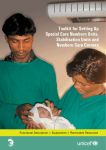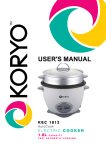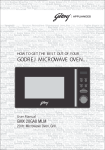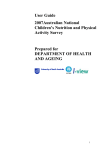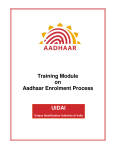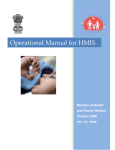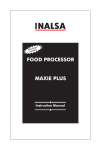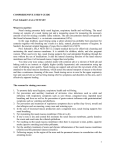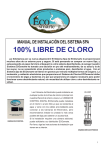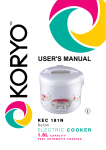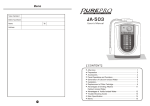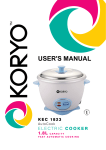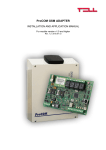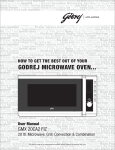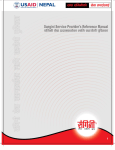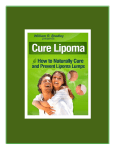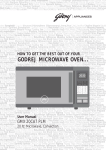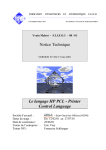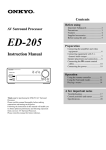Download A Guide For Use of the Mother-Child Protection Card
Transcript
A Guide For Use of the Mother-Child Protection Card For THE COMMUNITY AND THE FAMILY AWW ANM & SECTOR SUPERVISORS 1 Item Page No. Newborn Care 16 Breastfeeding 17 Weigh the Baby 18 Danger Signs: See the Health Worker 20 Details of Immunization and Vitamin A 21 Growth Chart 24 Care During Illness: Diarrhoea 26 Care During Illness: Acute Respiratory Infection 27 Care During Illness: Fever 29 Item Page No. Children 1 to 2 years 44 Feeding 44 Development 46 Development Milestones 47 Children 2 to 3 years 49 Feeding 49 Development 51 Development Milestones 52 Key Feeding Problems and Possible Solutions 54 Care for Development Problems and Possible Solutions 56 MOTHER AND CHILD PROTECTION CARD Why the card? The Mother and Child Protection Card has been developed as a tool for families to learn, understand and follow positive practices for achieving good health of pregnant women, young mothers and children. Card helps families to know about various types of services which they need to access for the health and well being of women and children. The card empowers families to make decisions for improved health and nutritional status and development of young children on a continual basis. Who uses the card? The card could be used by the following individuals and groups. A. Family members (Mothers, Fathers, Mother-in-laws, Adolescent girls and others) 1. 2. 3. 4. For gaining knowledge related to children’s health, nutrition and development. For using all available services. For practicing optimal care behaviors. For monitoring and promoting growth and development of children. B. Village groups/Women (Mahila Mandal) groups 1. As a discussion tool in the meetings. 2. Monitoring effective service delivery in the area. C. ANM / AWW 1. For educating families about optimal health, nutrition and care practices. 2. For recording information on utilization of services. 3. For appropriate referrals. D. Health and ICDS Supervisors For ensuring that: 1. the card is introduced to the targeted families; 2. its use is properly explained to the families with support materials; and 3. there is effective and efficient delivery of services to the target families. Who are the specific target groups for the card? 1. Pregnant women 2. Families with children under 3 years of age Who keeps the card? 1. Pregnant women 2. Mothers of children under 3 years of age 3 Recording of information The ANM / AWW should record the desired information in the place provided in the card. It is not necessary to duplicate the recording of weights of children in the growth charts at the AWC. The information recorded in the card does not replace any of the routine information recorded by the workers in their registers. How to use the Card Information on the cover page on Family Identification and Birth Record should be filled in before the card is given. Families should be advised to bring the card along when they visit AWC, subcenter, health center, private doctor and a hospital. Families should be advised to keep the card in a safe place to prevent it from wear and tear. The various sections of the card should be explained using support material before the card is given to the target families. Use the guide not only to inform mothers and family members but also to enlist them as partners in promoting child survival, growth and development. The content and skills can be easily mastered after continuous practice. In order to make the guide user friendly, it has been colour coded. Colours in the guide are matched with the colours of the card. Yellow colour has advice/information that the ANM/AWW must explain to the mother and family members. The reasons/details are given below the yellow box. Green boxes have instructions/ advice that the family must follow/ensure. Red denotes danger and requires immediate contact with medical provider. Danger signs/ information is in red boxes or written in red letters. Pink boxes require ANM/AWW to record/fill the information in the card. Blue boxes and writing in blue is important information for the ANM/AWW, which she must understand before counseling the mothers. How to be a good counsellor For effective communication skills and developing and maintaining relationship with the family members use communication skills given on page 30 This support material should be used while explaining the Mother and Child Protection Card 4 FRONT COVER AWW should fill in as much information as she can with the help of the family This panel will be replaced once we get the modified panel Family Identification Name & Address Fill in the names and the address Mother’s Education Tick one of the options Birth Record Date of Birth Fill in the correct date In case of doubt, help the woman determine the date with the help of local calendar / events /festivals. Birth Weight The birth weight is recorded in grams If the child is born at home, the weight should be taken immediately and recorded in the card. If the child is born in hospital, birth weight should be recorded by the hospital authorities. Birth Registration No. Fill in the number If the Birth Registration number of the child is not available, ask the family to register the child with the panchayat / local authorities and obtain a Birth Registration Number. Pregnancy Record Date of last menstrual period Fill in the correct date as reported In case of doubt, help the woman determine the date with the help of local calendar / events / festival Expected Date of Delivery Fill in the expected date Calculating nine months and seven days from the first day of the last menstrual period. No. of Pregnancies / Previous live births Fill in the information in the box split into two smaller boxes Find out (i) how many times the woman has been pregnant (this includes miscarriages, abortions and still births) and (ii) how many living children she has. Last delivery conducted Put a cross either in the Institution or Home box Find out where the last delivery was conducted 5 Institutional Identification Fill in the names and addresses Anganwadi / Block——————SHC /Clinic ——————PHC / Town—————————— Hospital ————————————— Anganwadi Registration Number ————————Sub Centre Registration Number ——————————Referral Fill in the date and place to which referral was made. PREGNANCY Regular checkup is essential during pregnancy Hints for the ANM / AWW Across Nine columns in this section depict Months of Pregnancy with pictures of pregnant women. The first column corresponds with the first month of pregnancy, the second with the second month of pregnancy and so on….. Down Six picture boxes depict services that a woman must seek during a pregnancy. The columns alongside each picture are for recording the appropriate information. The worker should explain to the mother each picture box and column as she moves down the side 6 REGULAR CHECKUP The ANM / AWW should keep a record of the pregnant women in their registers Registration ANM / AWW Explains A woman must register with the ANM and AWW during the first three months of the pregnancy. The pregnant woman must take her Mother and Child protection card from the ANM/AWW and seek explanation from them. It is very important to get good antenatal care during pregnancy as it i helps to improve the health of the mother; ii improves the chance of giving birth to healthy baby; and iii helps to detect and treat complications early before they become fatal for mother or the baby. ANM / AWW Records The date of registration in the relevant column under the month of pregnancy. They also register the pregnant woman in their respective registers. Antenatal Care ANM / AWW Explains A woman should have at least three antenatal check ups during the pregnancy. In case of any problem, more checks may be required. The first check-up should be prior to the third month of pregnancy As far as possible, the second check-up should be during the seventh month of pregnancy The third check-up should essentially be during the ninth month Abdominal examination is very necessary as it i helps in measuring the size of the baby. This indicates whether the baby is growing normally; and ii helps in monitoring the baby’s heart beat. ANM/AWW Records The date of the abdominal examination under the month of pregnancy column. ANM also records the information in her register. 7 REGULAR CHECKUP Blood Pressure ANM / AWW Explains A pregnant woman must have her blood pressure checked at each visit. It is important to have blood pressure checked High blood pressure can be fatal both for the mother and the baby. If the blood pressure is above 130/90, the doctor should be contacted. ANM / AWW Records Dates and the blood pressure reading under the pregnancy month column. ANM also records this information in her register. Weight ANM / AWW Explains A pregnant woman must have her weight checked at each visit. Total gain in weight during the entire period of pregnancy should be around 10–12 kg. Gain should be at least 1 kg every month during the last 6 months of pregnancy. Taking weight is essential i If the weight gain is less, the baby may be small at birth and less able to grow, stay healthy and develop well. If the weight of the child is less than 2.5 kg. s/he will be more vulnerable to disease and death. ii If the weight gain is inadequate, extra food should be eaten at every meal, and the number of meals should be increased. A pregnant woman also requires rest at least two hours during the day. ANM / AWW Records The date and weight of the woman under the pregnancy month column. She also records this information in her register. TT(Tetanus Toxoid) Injection ANM / AWW Explains A pregnant woman must take Tetanus Toxoid (T.T.) injections. The first T.T. injection should be taken during the second trimester. The second T.T. injection should be taken one month later. If the T.T. injection has been received during the previous pregnancy less than 3 years ago, only one injection should be taken. TT injection/s must be taken one month before delivery. Tetanus Toxoid injections during pregnancy are essential The T.T. immunization protects the mother and the baby against tetanus – a life threatening disease. ANM / AWW Records Date of TT injection under the month of pregnancy column. She also records this information in her register. 8 Iron Tablets REGULAR CHECKUP ANM / AWW Explains A pregnant woman must take one iron tablet a day for at least 3 months. She must take at least 100 tablets. Anaemia is a very common condition during pregnancy. i Anemia during pregnancy leads to pre-mature delivery, still birth, and low birth weight babies. ii Severe anaemia can lead to the death of the woman during childbirth. Symptoms of anaemia are: General fatigue Breathlessness on routine and somewhat strenuous work Palpitation Loss of appetite Sensation of tingling and pins and needles in the fingers and toes Giddiness, dizziness, diminishing vision, and headache Paleness of eyes, nails and insides of eyelids. A pregnant woman should consume a diet containing green leafy vegetables, wheat, ragi, jowar, bajra and pulses. Taking Vitamin C rich foods like amla, guava, oranges at the same time helps in absorption of iron. Tea should not be taken 1 hour before or after taking meals or Iron and folic acid tablets. It does not allow absorption of iron. Intake of iron tablets may cause stools to become either loose or hard. The color of the stools may also become black. This should not be a cause for worry. ANM/AWW Records Date and number of iron folic acid tablets given under the month of pregnancy column. 9 REGULAR CHECKUP Vitamin A Do you have problems seeing in the dark: Yes / No ANM / AWW Explains A pregnant woman must include dark green leafy vegetables like spinach, amaranth, cholai, deep yellow fruits like papaya, mango and melon and if possible, milk and milk products, fish and eggs. If the pregnant woman’s diet is low in Vitamin A rich foods, she can develop Vitamin A deficiency. i Vitamin A deficiency causes night blindness. A woman may have difficulty seeing in the dark compared to the time when she was not pregnant. ii Vitamin A is required for the normal growth of growing baby in woman’s womb. ANM / AWW Records AWW/ANM checks on the card, whether the woman has problems seeing in the dark. If yes, then woman is explained about increasing the consumption of Vitamin A rich foods. Any other problems during pregnancy ANM/AWW Records If the woman has any other problems during pregnancy, it is recorded briefly on the card and appropriate referral made. 10 CARE DURING PREGNANCY Diet ANM / AWW Explains A pregnant woman should consume more food, more often during the day. She should consume a variety of foods like cereals and whole grains, green leafy vegetables, fruits, lentils and beans, milk and its products, and meat and eggs. She should use only iodised salt. A pregnant woman requires extra food to: i meet the demands of the growing baby; and ii provide for changes in her body. Taking extra foods helps in gaining adequate weight gain during pregnancy and contributes to increasing the weight of the baby. Iodised salt prevents abortion, still and pre-term births. Family Ensures The pregnant woman eats along with her family. She should not be the last one to eat. She does not avoid any foods during pregnancy and also does not observe fast during pregnancy. Alcohol and tobacco are not be used during pregnancy. Medicines are taken only when prescribed by the doctor. Rest ANM/AWW Explains: A pregnant woman should get at least two hours of rest during the day. Routine activities should be interspersed with short periods of rest throughout the day. While resting, she should always lie on the left side of the body. Family Ensures The pregnant woman avoids doing strenuous work in the house. Family members offer help in doing household chores. 11 EMERGENCY If you or anyone in your family sees any of these danger signs, take the woman to the hospital immediately All pregnant women are at risk of developing complications. In some women these complications can occur without warning . It is important that the pregnant woman and her family be aware of the danger signs and be able to recognize these signs. Pregnant woman must also bring it to the notice of the family members, in case she develops any of the danger signs. Hints for ANM / AWW The danger signs should be explained to all pregnant women and their families during the antenatal checkups as well as during the group meetings If timely treatment is not sought, it can result in death or disability of the woman or child or both A pregnant women with danger signs should be taken to the FRU /hospital immediately. The identified first referral unit (FRU)/hospital means that it must have the following: - A gynecologist. - Facilities for blood transfusion. - Operation theatre and anesthetist. - Oxygen and life-saving medicines. - X – Ray and laboratory diagnosis. Emergency Family Ensures Danger signs are recognized during pregnancy, delivery and after delivery. Adequate money is saved in advance for meeting the cost of emergency. A nearest FRU/hospital is identified in advance. Fast means of transport is arranged in advance to take the woman to the hospital. 12 DANGER SIGNS Bleeding during pregnancy or delivery ANM/AWW Explains A woman bleeding during pregnancy or delivery should be immediately taken to the hospital. Any bleeding during pregnancy or excessive bleeding during /after delivery can can be fatal for the mother and/or baby. Family Ensures During transportation, the woman lies on her left side and is kept covered and warm. Severe anaemia with or without breathlessness ANM/AWW Explains A pregnant woman with severe anaemia must deliver in a hospital. Anemia during pregnancy can lead to many other complications like heart failure at the time of childbirth, pre-term labor and infections during pregnancy. Women with severe anemia have pale eyelids, nails and palms. They may or may not have breathlessness. Family Ensures During the antenatal check-ups it must be determined if the woman has severe anaemia. If so be sure she receives and takes iron tablets daily until no longer anaemic High fever during pregnancy or within one month of delivery ANM/AWW Explains If a woman has high fever during pregnancy or within one month of delivery, she should be taken to hospital immediately. High fever is an indication of some infection in the woman. It can be harmful for the growing baby. Family Ensures The woman is kept covered and warm during transportation Wet, cold sponging is used to bring down the fever 13 DANGER SIGNS Convulsions or fits, blurring of vision, headache, sudden swelling of feet ANM/AWW Explains Convulsions or fits, blurring of vision, severe headache, sudden swelling of feet can occur during pregnancy, delivery or after delivery. A woman with these symptoms should be immediately taken to the hospital. This condition can cause brain damage in the mother and the unborn baby. It can also lead to the death of the mother and the baby before s/he is born. Family Ensures If a woman has convulsions or fits, blurring of vision, headache, sudden swelling of feet, she is taken to the hospital as early as possible. Labor pain for more than 12 hours ANM/AWW Explains If the woman has been in labor pain for more than 12 hours, she should be immediately be taken to the hospital. The woman should deliver in the presence of a doctor. In case the timely delivery is not performed, it can result in the death of the woman and the child. Family Ensures The woman is immediately taken to the hospital. Bursting of water bag without labor pain ANM/AWW Explains In case the pregnant woman has bursting of water bag without labor pain, she should be immediately taken to the hospital. The delivery should be conducted in the presence of a doctor. The woman and the baby have greater chances of developing infection in case the water bag bursts. Family Ensures The woman is immediately taken to the hospital. 14 PREPARATION FOR HOME DELIVERY ANM / AWW Explains As far as possible, delivery should be conducted in a hospital. If delivery is conducted at home, it should only be conducted by a trained dai or an ANM. Women and newborns can easily get infected during and after delivery. Pregnant woman/family should also try to get a disposable delivery kit (DDK) before delivery. DDK is available at all Government hospitals and health centers. If DDK is available, then it would contain clean blade and thread. Family Ensures The delivery is conducted by a trained person Family should follow the five clean practices as stated below: i Clean Hands – Hands must be thoroughly washed with soap and water by the person before conducting the delivery. After washing, hands should be air dried and not wiped to avoid infection. Nails must be cut and bangles, rings etc. must be removed before washing hands. ii Clean surface and surroundings: a) Clean sheet – The sheet on which woman plans to deliver must be washed with soap and water and dried in sun. b) Clean room – The room in which delivery is planned should be freshly whitewashed and cleaned thoroughly. Shoes/chappals should not be allowed inside. iii Clean blade – The blade for cutting the cord must be new and unopened. iv Clean umbilical cord – Nothing should be applied to the cord to avoid risk of infection v Clean thread – This must be washed with soap and water, then boiled for 20 minutes and dried in sun. Women will have vaginal discharge (bleeding) for few days after the delivery. Only clean pieces of cloth (washed and dried in sun) should be used. ANM / AWW Records After delivery the worker fills in the space for the ‘Birth Record’ of the baby on the cover page. 15 NEWBORN CARE Newborn care starts soon after the baby has been delivered. NEWBORN CARE Keep child warm Do not bathe child for first 7 days Start breastfeeding immediately after birth, give nothing else not even water Keep the child away from people who are sick Weigh your child at birth Give special care if child is less than 2.5 kg. ANM / AWW Explains Keep the baby warm Immediately after delivery, newborn should be cleaned with a soft moist cloth and then wiped with a soft dry cloth. Baby should be kept close to mother’s chest and abdomen. Baby should be wrapped in several layers of clothing/ woolen clothing depending upon the season. The room should be warm enough for an adult to feel just uncomfortable. The room should be free from strong wind. The newborn has lived in a warm and protected environment in the womb and needs to be protected from cold after delivery. The newborn baby is not able to produce sufficient heat for keeping its body warm. The baby can become very cold, if not kept warm by other means. ANM / AWW Explains Do not bathe the baby for the first seven days The baby should not be given a bath for one week after birth. Bathing can expose the baby to cold which can be fatal. 16 NEWBORN CARE AWW/ANM Explains Start breast-feeding immediately after birth. Give nothing else, not even water Baby should be put to the mother’s breast even before placenta is delivered. It is useful for both the baby as well as the mother. Benefits for the baby: Early skin to skin contact with the mother gives warmth to the baby It helps in early secretion of breast milk Feeding first milk (colostrum) protects the baby from diseases Helps mother and baby to develop a close and loving relationship Benefits for the mother: Helps womb to contract and the placenta is expelled easily Reduces the risk of excessive bleeding after delivery For getting maximum benefit of breastfeeding, the baby should be held in the correct position and be put correctly to the breast The baby is in the correct position when: While holding the baby, the mother also supports the baby’s bottom, and not just the head or shoulders Mother holds the baby close to her body The baby’s face is facing the breast, with nose opposite the nipple The baby is put correctly to the mother’s breast when: The baby’s chin touches the breast The baby’s mouth is wide open The baby’s lower lip is turned outside Most of the aerola (dark part around the nipple) is in baby’s mouth Breast feed as often as the baby wants and for as long as the baby wants. Baby should be breastfed day and night at least 8–10 times in 24 hours. Feeding more often helps in production of more milk. More the baby sucks more milk is produced. 17 NEWBORN CARE Baby should not be given any other liquid or foods such as sugar water, honey, ghutti, goat’s/cow’s milk and not even water. Giving other food or fluid may harm the baby in following ways: It reduces the amount of breast milk taken by the baby. It may contain germs from water or on feeding bottles or utensils. These germs can cause diarrhoea It may be too dilute, so the baby becomes malnourished. It may not contain enough Vitamin A. Baby does not get enough iron from cow’s and goat’s milk and may thus develop anemia. Baby may develop allergies. Baby may have difficulty digesting animal milk, so that milk causes diarrhoea, rashes, or other symptoms. Diarrhoea may become persistent. Breast milk provides all the water a baby needs. Babies do not need extra water even during the summer months. ANM/AWW Explains Keep the baby away from people who are sick People who are sick with cold, cough, fever, skin infection, diarrhoea etc. should not hold the baby or come in close contact with the baby. The newborn should not be taken to places where there are other sick children. The newborn should also not be taken to places where there are large gatherings of people. The newborn can easily fall sick by catching an infection. ANM/AWW Explains Weigh the baby at birth Baby should be weighed within 2 days of birth. It is important to weigh the baby after birth because babies may require special care on the basis of the birth weight. If the baby’s weight is in the green zone (as indicated in the color coded spring balance), baby can be managed with normal care as described above. If the baby’s weight is in the yellow zone, the baby can be managed at home with extra care as given below. If the baby’s weight is in the red colored zone, baby is very small and must be referred to the health center and examined by a doctor. These babies also need extra care as given below. 18 NEWBORN CARE ANM/AWW Explains Give special care if child is less than 2.5 kg. Babies whose weight is in the yellow or red zone are small and require extra care as follows: Provide extra warmth Family Ensures Baby is wrapped well with thin sheets and blankets. The head is covered to prevent heat loss. The baby is kept very close to the mother’s abdomen and chest. Warm water filled bottles wrapped in cloth may be kept on either side of the baby’s blankets. Ensure adequate and frequent feeding Family Ensures Baby is breastfed very frequently in small amounts. A small baby has difficulty suckling at the breast and easily gets tired. In case the baby suckles extremely slowly at the breast, mother can express her breast milk into a clean container and feed the baby with a spoon and katori. Prevent infections A low birth weight baby is easily susceptible to infections. Family Ensures People who have infections should keep away from the baby at least during the first month. In addition to this, not too many people should be allowed to handle the baby. People should wash their hands with soap and water before touching the baby. The room should also be clean and dust free. 19 NEWBORN CARE Danger Signs Newborns sometimes develop life-threatening problems. Families should recognize the signs of these problems early and take the baby to the nearby hospital. The signs are: Baby does not suck or sucks poorly at the breast Baby does not cry and /or has difficulty in breathing Baby is cold or hot to touch Baby develops yellow staining of palms and soles Baby has abnormal movements (convulsions) Baby is excessively drowsy or cries continuously Baby has birth defects Family Ensures Baby is kept warm. Baby is put to the mother’s breast immediately after birth. Baby is kept away from people who are ill. Baby is weighed soon after birth. Special care is provided if the baby is low birth weight. If any danger sign is recognised, baby should be taken to hospital immediately. 20 DETAILS OF IMMUNIZATION Hints for the ANM/AWW The schedule in the card gives information about the immunization and the doses of the Vitamin A to be given to the child during the first three years. Boxes in the chart indicate each type of vaccine, date to be given, date when it was given and the age. Pink row on top of each box is for filling the date when the child is expected to come for next immunization. White row on the bottom of each box is for filling the date when the child actually came for immunization. Immunisation Immunisation increases the body’s ability to fight diseases. Immunization prevents the child from developing seven fatal diseases. These diseases can cause death and disability in the children. Vaccines that are administered to prevent these diseases areBCG : Tuberculosis Hepatitis B : Hepatitis B OPV : Polio DPT : Diphtheria, Pertussis (whooping cough) and Tetanus Measles : Measles Vitamin A Vitamin A supplements are given to protect the child against blindness due to Vitamin A deficiency. Vitamin A also reduces illness and deaths in children. Child should be given total five doses of Vitamin A drops starting from 9 months through 3 years of age, every six months. It is important that child be given the vaccine at the right age at the right time. Full course should be completed for all the vaccination. 21 DETAILS OF IMMUNIZATION Immunization and Vitamin A : 0-12 months ANM / AWW Explains A baby should be taken to the sub-centre/AWC at 1½, 2½, 3½ and 9 months of age for immunization. During 0-12 months, baby must be given BCG, Hepatitis B, OPV,. DPT and Measles immunization. First Vitamin A dose is also given at 9 months of age along with measles vaccination. Immunization and Vitamin A : 12-24 months ANM/AWW Explains The child should be taken to the health center/AWC for DPT and polio at 18 months and administration of Vitamin A dose at 18 and 24 months. During 12-24 months, the child needs one booster dose of DPT and Polio vaccines and two doses of Vitamin A supplements Vitamin A supplement : 24 to 36 months ANM/AWW Explains The child should be taken to the health center/AWC for administration of Vitamin A doses at 30 and 36 months. During 24 to 36 months, child needs 2 doses of Vitamin A supplements. Alert If after the immunization, the child develops high fever, seek the help of ANM/ AWW for referral to a health center. After the immunization reactions like mild rash, fever or small sore may develop. It should not be a cause for worry. 22 DETAILS OF IMMUNIZATION Family Ensures Child is taken for immunization five times in the first year of life: At birth or as soon as possible, for BCG vaccination and polio drops (called the zero dose which is given before the first dose) At 1½ months for first dose of DPT, polio and Hepatitis B At 2½ months for second dose of DPT, polio and Hepatitis B At 3½ months for third dose of DPT and polio At 9 months for measles, third dose of Hepatitis B and Vitamin A supplement Full course is completed for each vaccination If for any reason, a date is missed for any vaccination, child to be brought as soon as possible after that for vaccination Child is taken for immunization even if there is mild fever, cough, cold and diarrhoea ANM / AWW Records The date in the white box when the child came for immunization The date in the pink box when the child is expected to come for next immunization 23 GROWTH CHART Have your child weighed at the AWC every month Hints for the ANM / AWW The worker should: First read and understand the ‘Feeding and the Care during Illness’ section in this Guide (p.26) Plot the weight on the growth chart correctly Understand the direction of the growth curve Decide if the child is growing well or growth faltering Explain the direction of the growth curve to the mother If the growth curve has moved in an upward direction, praise and encourage good caring practices If the growth curve has moved in the downward direction or remains flat, explain some of the problems (e.g. poor diet and/or illness) that might have caused that Ask the mother questions about child’s feeding (refer to feeding section) Find out about child’s current/ previous illness, if any Make judgement and suggest appropriate actions (refer to the section on ‘Feeding Recommendations and Care during Illness’) depending on specific situation of the child Impor tant actions would includeimproving the diet, improving psychosocial are, care during illness, referral to a health facility and/or any other as judged by the AWW in consultation with the family 24 Growth chart AWW Explains Take your child regularly every month at the AWC for weighing Each time the child is weighed , the weight must be recorded by marking a point on the growth chart for age of the child. These points are joined by a line. This line is called a growth curve. If your child is growing well, the curve will go up. Importance of Growth: A growing child is a healthy child; a child who is not growing is not healthy. Children grow very rapidly between 0-3 years. There are many ways of measuring the growth of the child e.g. (getting taller, clothes becoming smaller etc.) However, the most available measure of growth is weight gain. Growth curve on the Growth Chart makes the growth of the child visible to the family Growth Indicators - Direction of the growth curve indicates whether the child is growing or not - An upward growth curve, showing adequate weight gain for the age of the child, indicates that the child is growing and is healthy - A flat growth curve indicates child has not gained weight and requires attention by the AWW and the mother - A downward growth curve indicates loss of weight and requires immediate attention by AWW and the family Steps to take when the child is not growing/ gaining weight: There are two main reasons for not gaining,or losing weight. These are: -Child has not been fed or cared properly and/ or; -s/he has been sick Once the child starts eating better and/or sickness has been cured, s/he will again start growing well. AWW / AWW Records Weight of the child on the growth chart Family Ensures Child is taken to the AWC every month for weighing. Weight of the child is plotted on the growth chart by the worker in front of the family. The direction of the growth curve is understood by the family. Care of the child is discussed with the worker. The worker is informed about any previous/current illnesses. Advice of AWW is sought and followed regarding feeding, care and care during illness for the child. 25 CARE DURING ILLNESS Diarrhoea Breastfeed more often Give extra fluids Give ORS Continue to give normal diet If loose motions do not stop, take the child to the health center Management of diarrhoea should begin at home as soon as the child passes the first loose or watery stool. Diarrhoea is the passage of loose or watery stools. This leads to loss of water from the body of a child and results in dehydration. If the water loss is not replaced in adequate quantity, the child can become dehydrated and even die. AWW/ANM Explains Breast feed more frequently and for longer time at each feed Give increased amounts of fluids during diarrhoea. Giving extra fluids can be life saving If the child is less than 6 months old and exclusively breast fed, give ORS in addition to breast milk If the child is over 6 months of age, give ORS as well as home available fluids like rice kanji (mand), Buttermilk (lassi), lemon water with sugar and salt (shikanji), dal soup, vegetable soup, fresh fruit juice (unsweetened) plain clean water or other locally available fluids Give as much fluids as the child will take. Extra fluids prevent dehydration due to diarrhoea. Always feed from a cup or spoon. Never use a bottle. Child should be given an extra amount of fluid each time s/he passes stools, in addition to the usual fluid intake. Continue to give normal diet to the child In addition to giving increased amounts of fluids, child should be given normal diet during diarrhoea. This is important as this will prevent malnutrition and also help the child to recover from illness. In case the child is not able to take the normal quantities of food, s/he should be given small quantities of food at frequent intervals. Child can also be given foods of thicker consistency such as Khichari, Dalia, sooji or rice in milk, idli etc.). 26 CARE DURING ILLNESS If loose motions do not stop, take the child to the health center Danger Signs: Take the child to a doctor immediately Not able to drink or suck on breast Becomes sicker Develops blood in stools Develops fever Family Ensures The danger signs should be recognized by the family and child should be taken to the doctor. After the illness, at least one extra meal should be given to the child for at least a week to help the child in speedy recovery. Small quantities of oil/ghee should be added to the food to provide extra energy. Acute Respiratory Infection If the child has rapid and / or difficult breathing, take the child to the health center AWW/ANM Explains If the child has rapid and / or difficult breathing, take the child to the health center Family should watch for any danger signs and take the child to the doctor as soon as these signs are seen. Danger Signs: Take the child to a doctor immediately Breathing fast Breathing with difficulty Not able to drink or breast feed Becomes sicker Develops fever 27 CARE DURING ILLNESS Cough, difficult breathing, fever and running nose are some of the common symptoms of respiratory infection in the children. Most children with respiratory infections recover on their own and can be treated well at home without any medicine. However, in some cases, children may develop pneumonia, which can be fatal. Home management for common cold or cough Keep the young child warm and away from the draught If the child’s nose is blocked and interferes with feeding, clean the nose by putting in nose drops( boiled and cooled water mixed with salt) and by cleaning the nose with a soft cotton wick Breastfeed frequently and for longer period at each feed. Exclusively breastfeed for six months Continue to give normal diet to the child Child should be given normal diet during cough and cold. This is important as this will prevent malnutrition and also help the child to recover from illness. In case the child is not able to take the normal quantities of food, s/he should be given small quantities of foods frequently. Child can also be given foods of thicker consistency such as Khichari, Dalia, sooji or rice in milk, idli etc.). Small quantities of oil/ghee should be added to the food to provide extra energy After the illness, at least one extra meal should be given to the child for at least a week to help the child in speedy recovery Give increased amounts of fluids Give extra fluids (as much as the child will take) such as: dal soup, vegetable soup, plain clean water or other locally available fluids. Always feed from a cup or spoon. Never use a bottle. For babies over six months of age, soothe the throat and relieve the cough with a safe home made cough remedy (made into a tea) such as - Sugar, ginger, lemon, tulsi leaves - Sugar, ginger, lemon, mint - Sonf, elaichi, ginger 28 CARE DURING ILLNESS Fever Use cold/wet sponge on the forehead and limbs during high fever and take the child to the health center ANM / AWW Explains Fever is a sign of some infection in the body If the child is hot to touch, it means s/he has fever. The warmer the body, the higher the fever. If the fever is very high cold, wet sponging must be started. The child should be taken to the hospital if the fever does not come down in one day. Wet sponging is continued even as the child is taken to the hospital In case the child is less than 2 months old and has fever, s/he should be taken to the hospital. Child should be breastfed more frequently and for longer time each feed. Child under 6 months should be exclusively breastfed In addition to breast milk a child over 6 months should be given extra fluids and normal diet during fever Family Ensures Child continues to be breastfed during illness Child continues to be given normal diet Child is given extra fluids Danger signs are recognized and the child taken to the doctor. The danger signs are: Is not able to drink or breastfeed Gets sicker Has high fever Has blood in stools Has fast and difficult breathing Is very sleepy and difficult to wake Is vomiting persistently Care giver follows the advice given by the health worker on giving medicines Child is taken back to the health center after specified number of days for follow up 29 FEEDING, DEVELOPMENT AND DEVELOPMENT MILESTONES Hints for ANM / AWW The card gives the recommendations for Feeding, Care for Development and Milestones for various age groups from birth to 3 years of age. The AWW/ANM needs to understand the recommendations and milestones for all age groups. However, she needs to ask the mother how the child is fed and cared for and then give only the advice that is needed for the child’s age and situation. The process is mentioned below: For Effective Communication Understanding of Milestones Ask questions to learn what are the existing practices. Compare the mother’s answer to the Recommendations for Feeding and Care for Development for the child’s age as given in this section. The worker should first understand the meaning of milestones before explaining this section to the mother. Milestones are signs in children which tell us about their progress as they grow and develop, e.g. children smile, talk and walk at certain ages. Listen to the mother’s answers and look at her behavior with her child. Listen and look what she is doing well as you compare with the recommendations. Also listen and look for the gaps where she needs to improve her actions to help her child grow and develop better. The worker should explain the meaning of milestones to the mother and tell her about the milestones specific to her child’s age-group. In case the child is almost at the end of an age group, discuss milestones for the next age group also. Praise her for what she is doing well. Encourage her to continue to do so. If the child is about to enter the next age group with different recommendations, explain these to her. Some children develop more slowly than othersmay be normal or a cause for concern if it occurs in several milestones and persists. Advise the mother if there are gaps between what she is doing and what is recommended. Explain the recommendations to her. If there are problems in Care for Development, suggest solutions. (This section gives the Recommendations for Care for Development and also gives some examples about common Care for Development problems. Check understanding: Ask questions to find out what the mother understands and what needs further explanation. 30 CHILDREN 0 - 6 MONTHS FEEDING ANM/AWW Explains Start breastfeeding immediately after birth and exclusively Baby should be put to the mother’s breast even before placenta is delivered. It is useful for both the baby as well as the mother. Benefits for the baby: Early skin to skin contact with the mother gives warmth to the baby It helps in early secretion of breast milk Feeding first milk (colostrum) protects the baby from diseases Helps mother and baby to develop a close and loving relationship Benefits for the mother: Helps womb to contract and the placenta is expelled easily Reduces the risk of excessive bleeding after delivery 31 CHILDREN 0 - 6 MONTHS FEEDING Baby should be held in correct position and be to put to the breast in the correct position to get maximum benefit of breastfeeding. The baby is in the correct position when: While holding the baby, the mother also supports the baby’s bottom, and not just the head or shoulders Mother holds the baby close to her body The baby’s face is facing the breast, with nose opposite the nipple The baby is put correctly to the mother’s breast when: The baby’s chin touches the breast The baby’s mouth is wide open The baby’s lower lip is turned outside Most of the aerola (dark part around the nipple) is in baby’s mouth Exclusively breastfeed for 6 months - this means do not give any other foods, drinks, not even water Baby should not be given any other liquid or foods such as sugar water, honey, ghutti, goat’s/ cow’s milk and not even water. Giving other food or fluid may harm the baby in following ways: It reduces the amount of breast milk taken by the baby It may contain germs from water or on feeding bottles or utensils. These germs can cause diarrhoea It may be too dilute, so the baby becomes malnourished It may not contain enough Vitamin A Baby does not get enough iron from cow’s and goat’s milk and may thus develop anaemia Baby may develop allergies Baby may have difficulty digesting animal milk, so that milk causes diarrhoea, rashes, or other symptoms. Diarrhoea may become persistent. Breastfeed as many times as the child wants Breastfeed as often as the baby wants and for as long as the baby wants. Baby should be breastfed day and night at least 8 – 10 times in 24 hours. Feeding more often helps in production of more milk. More the baby sucks more milk is produced 32 CHILDREN 0 - 6 MONTHS FEEDING Family Ensures The baby is put to the mother’s breast immediately after birth. The baby is breastfed as often as the s/he wants and for as long as the s/he wants. Baby is breastfed day and night at least 8 – 10 times in 24 hours. The baby is fed no other liquid or food like sweetened or plain water, ghutti, cow or goat’s milk, not even water for 6 months. No pacifiers are given to the baby. Hygiene practices by mothers/caregivers: Caregiver should wash hands with soap and water before feeding the child. Caregiver should wash hands with soap or ash after washing baby who has defecated, and after baby’s excreta has been disposed. Continue breastfeeding during illness. The child needs extra food after illness. Always use iodized salt for the family. 33 CHILDREN 0 - 6 MONTHS DEVELOPMENT Birth to 3 Months ANM/AWW Explains What you can do... Smile at your child, look into child’s eyes and talk to your child Hold the infant on his/her back with your face about 12 inches above the infant’s face. Now, look into infant’s eyes at him/ her. The infant will look back and by 6 weeks will smile in return. Provide ways for the child to see, hear, feel and move Hug and cuddle your child. Being held securely gives the child great comfort. Hugging and cuddling the baby helps develop the bond of love between the mother and the child. Family Ensures Immediate response to the baby’s cries. Gentle rocking and walking with the baby will soothe the baby. Feeding, playing and communicating with the children helps them grow and develop well 34 CHILDREN 0 - 6 MONTHS DEVELOPMENT 3 Months to 6 Months ANM/AWW Explains What you can do... Have large colourful objects for your child to see and to reach for Child at this age likes to reach for objects. Clean, safe and colorful things from the household, such as metal cup or a plastic bowl or a colorful toy, can be shown to the child so that s/he can reach for it and touch it. Talk and respond to your child. Get a conversation going with sounds or gestures Child, now, enjoys making new sounds, like squeals and laughs. S/he responds to someone’s voice with more sounds, copy sounds s/he hears, and starts learning about how to make a conversation with another person. Family Ensures All family members can smile, laugh, and talk to the child, and “coo” in response to the child’s sounds. They will enjoy the responses that they get from the child. Feeding, playing and communicating with the children helps them grow and develop well 35 CHILDREN 0 - 6 MONTHS DEVELOPMENT MILESTONES Birth to 3 Months ANM/AWW Explains Around 3 months what most children can do. Can your child also do this? Smile in response Hold the infant on his/her back with your face about 12 inches above the infant’s face. Now, look into infant’s eyes and smile at him/ her. The infant will slowly notice you and learn to smile back at you. Track a ribbon bow When the child is lying on the back, you can hold a small dangling object (like a ribbon bow), about 12 inches away from the child‘s face and slowly move it from one side to the other. By about three months, the child will follow the complete movement, with head and eyes, looking at the object. Begin to make sounds Talk very gently to your child by saying pleasant words, which will not have meaning but which sound loving. The infant will respond to the tone of the voice and by third month the child might make ‘ooh’ and ‘aah’ sounds. If the child seems slow, increase feeding, talking and playing. If the child is still slow, take the child to a doctor. 36 CHILDREN 0 - 6 MONTHS DEVELOPMENT MILESTONES 3 Months to 6 Months ANM/AWW Explains Around 6 months what most children can do. Can your child also do this? Hold head steady when held upright The child learns to hold his/her head erect. When the head is steady the infant should be held firmly supported, in a sitting position so that s/he can see what is going on. Reach out for objects Securely suspend a crib toy over the child’s cot so that the child can reach for it. The child will try and reach out for it, which will help him/ her to develop coordination. Turn to a voice Even though the child cannot speak, s/he is developing language skills by listening to the words spoken to him/her. Call the child’s name from behind the child where the child cannot see you–the child should turn towards the sound. If the child seems slow, increase feeding, talking and playing. If the child is still slow, take the child to a doctor. 37 CHILDREN 6 - 12 MONTHS FEEDING AWW / ANM Explains At 6 months, the child should be given small amounts of soft mashed cereal, dal, vegetables and seasonal fruits. Offer a variety of foods as after 6 months of age, breast milk alone is not enough to meet the nutritional needs of the child for growth and development. Some examples include: - Thin gruels made from roasted whole wheat flour, or flour of other cereals, or sooji and milk. - Mashed potatoes, soft fruits like banana, mango and papaya - Soft cooked and mashed rice and dals Introduce one type of food at a time. If the child develops an allergic reaction to a specific type of food, it can be easily detected and the food stopped immediately. 38 CHILDREN 6 - 12 MONTHS FEEDING Increase the quantity, frequency and thickness of food gradually Offer foods frequently in small amounts At 7-9 months, child should be given at least ½ katori food /sitting, 4 times a day (total 2 katoris food/day) At 10-12 months, child should be given at least ½ katori food/sitting, 5 times a day ( total 2½ katoris food/day) Small amount of oil or ghee should be added to child’s food to provide for extra energy Offer foods rich in micronutrients especially iron and Vitamin A Child should be given foods rich in iron, essential for healthy growth of the child’s body and brain. Deficiency of iron can lead to anaemia. Iron rich foods include breastmilk, dark green leafy vegetables, sprouted pulses and cereals, animal foods meat, eggs and liver Vitamin C rich foods should be given at the same meal with the iron rich foods. Vitamin C rich foods help in getting iron from the iron rich foods. Vitamin C rich foods are fresh fruits such as guava, orange, lemon, mango, melon, amla and vegetables like tomatoes, capsicum and green leafy vegetables Tea/coffee should not be given to young children. It also prevents getting the iron from the food Child should also be given foods rich in Vitamin A. Vitamin A is essential for normal growth and good health. It is needed for keeping the eyes healthy. It also protects the children from getting many diseases. Child should be given Vitamin A rich foods everyday. These include spinach, deep yellow and orange vegetables e.g. carrots, pumpkin, yellow and orange fruits e.g. mango, papaya, milk, butter, egg and liver Breastmilk, particularly first milk produced immediately after birth is very rich in Vitamin A 39 GHEE CHILDREN 6 - 12 MONTHS FEEDING Understand child’s signals for hunger and respond accordingly Child should be fed whenever s/he is hungry. Responding to the child’s signals for hunger/satiety helps the child learn that s/he is special , safe and cared for. This builds the child’s confidence, which will help the child throughout life Sit with the child and feed the child Caregiver should encourage the child to eat by showing interest, smiling, or offering an extra bite The child should not be forced to eat or threatened. This results in her / his eating smaller amounts of food. The child should be fed from a separate bowl and not made to compete with older siblings for food from a common plate. Child should continue to be breastfed as often as the child wants, day and night. Complementary foods should be given after breastfeeding to avoid replacing breast milk If the child is given animal milk or any other drinks including water, it should only be given by cup, not by bottle Family Ensures At 6 months, child is given small amount of soft and mashed foods like cereals, dals, fruits and vegetables. The consistency, quantity and frequency of foods are gradually increased. Mother / caregiver must understand child’s signals for hunger and respond accordingly. Mother / caregiver sits with the child and actively feeds the child by keeping him/her interested in the food. The child continues to be breastfed. Iodized salt is used in the child’s (as well as family’s) food. Hygiene practices by mothers/caregivers: Caregiver should wash hands before the preparation of child’s food and feeding the child. The child’s hands should also be thoroughly washed with soap and water before meals Caregiver should wash hands with soap or ash after washing the baby who has defecated, and after the baby’s excreta has been disposed Caregiver should keep the floor and play of children clean by keeping it free of urine and excrement of farm animals and humans. Continue breastfeeding during illness. The child needs extra food after illness. Always use iodized salt for the family. 40 CHILDREN 6 - 12 MONTHS DEVELOPMENT 6 Months to 12 Months AWW / ANM Explains What you can do... Give your child clean safe items to handle and things to make sounds with At this stage the child starts exploring his surroundings and enjoys making noises by hitting or banging with a cup and other objects. Give him / her safe items to handle. Play games like peek-a-boo and bye bye. Tell the child names of things and people Child also enjoys playing “peek a boo”. You cover your face with a cloth and then remove the cloth (the worker must demonstrate, ‘how it is done’, to the mother). The child will be fascinated when you reappear and will soon be able to pull the cloth off even when placed on the child’s face. The child will laugh and ask for this game to be played over and over. Family Ensures Family members can help the child learn to speak by talking to him/ her and telling the names of things and people. Even before the child says words, s/he learns from what family members say to him/ her, and can understand a lot. S/he copies the sounds and actions of older siblings and adults. Feeding, playing and communicating with the children helps them grow and develop well 41 CHILDREN 6 - 12 MONTHS DEVELOPMENT MILESTONES 6 Months to 12 Months AWW / ANM Explains Around 9 months what most children can do. Can your child do this? Sit up from lying position While the child is lying down (on back or stomach), encourage him/her to get into a sitting position. The child will slowly learn to roll to one side and then sit up using the arms for support. Sit without support Place your child in a sitting position in a corner to prevent the child from falling over. Hold the child in a sitting position on the floor. Making sure the child does not fall, slowly remove your hands. The child may initially, place hands on legs or on the floor for support. This will help the child to learn to sit. Pick up with thumb and finger Let the child pick up small bits of food, like puffed rice, with thumb and fingers. Slowly the child will start to pick up small objects easily. Please see to it that the child does not put harmful objects in the mouth. If the child seems slow, increase feeding, talking and playing. If the child is still slow, take the child to a doctor. 42 CHILDREN 6 - 12 MONTHS DEVELOPMENT MILESTONES 6 Months to 12 Months AWW / ANM Explains Around 1 year what most children can do. Can your child do this? Stand well without support Provide the child a secure support by sitting on the floor and placing the child’s hands on your shoulders or knees. After the child seems balanced, try to remove the support for a few seconds at a time. This way, the child will gradually be able to stand independently. While the child is standing holding on to a bench or low table encourage the child to take few steps by placing a toy at a little distance on the bench or low cot. The child will gradually walk a few steps with the support. If the baby is not yet ready to walk alone wait a few weeks and try again. Says papa / mama As you smile and encourage the child, the first words, like mama/ papa, take meaning and delight the family. Waves bye bye Face the child and say salaam, or namaste while gesturing to the child, on meeting the child. As this is repeated often over several days, the child will slowly learn to greet others. You can also teach infants to wave “bye-bye” while waving to the child. The child will learn to respond by raising his/her arm or waving with hands or fingers. If the child seems slow, increase feeding, talking and playing. If the child is still slow, take the child to a doctor. 43 CHILDREN 1 - 2 YEARS FEEDING AWW / ANM Explains Continue to offer a wide variety of foods such as rice / chappati, pulses, green leafy and other vegetables, yellow and other fruits, and milk and milk products, meat, fish and eggs should be given. The child should be given Iron rich foods and Vitamin A rich foods as explained earlier. The child should be given nutritious foods that s/he can hold and eat. This helps the child remain interested in food. 44 CHILDREN 1 - 2 YEARS Feed the child about five times a day (3 meals+ 2 extra feedings/day) Feed the child from a separate bowl and mother /caregiver should watch how much food the child actually eats. The child should also be allowed to feed himself/herself using a spoon. However, children at this age still need help to eat. They eat slowly and easily get distracted. Caregiver should continue to sit with the child and actively feed the child. The child should be continued to be breast fed as long as s/he wants. If the child is given animal milk or any other drinks including water, it should only be given by cup, not by bottle. Family Ensures The child is offered chopped up family foods 5 times a day. A wide variety of foods – rice, chapati, vegetables, yellow and other fruits, pulses and milk and milk products are offered to the child. The child’s hands are washed and s/he is offered foods that s/he can hold and eat. Mother/caregiver sits with the child and actively feed the child. The child continues to be breast fed as long as s/he wants. Hygiene practices by mothers/caregivers: Caregiver should wash the hands before handling and serving child’s food. The child’s hands should also be thoroughly washed with soap and water before meals Caregiver should wash hands with soap or ash after washing the baby who has defecated, and after the baby’s excreta has been disposed Caregiver should keep the floor and play area of children clean by keeping it free of urine and excrement of farm animals and humans Continue breastfeeding during illness. The child needs extra food after illness. Always use iodized salt for the family. 45 CHILDREN 1 - 2 YEARS DEVELOPMENT Recommendations for ages 1 to 2 years AWW / ANM Explains: What you can do... Give your child things to stack up and put into containers and take out The child likes to put things into cans and boxes, and then take them out. S/ he also likes to stack things up until they fall down. Mothers can give the child safe things to play with and encourage him/ her to learn new skills by playing with the child and offering help. Ask your child simple questions. Respond to your child’s attempts to talk Mothers/caregivers should use every opportunity (e.g. while feeding or bathing the child) to make conversations with the child. They can also ask the child some simple questions starting with, ‘where is…’, which they can answer by pointing to the object being talked about. Feeding, playing and communicating with the children helps them grow and develop well 46 CHILDREN 1 - 2 YEARS DEVELOPMENT MILESTONES 12 Months to 18 Months AWW / ANM Explains: Around 1 ½ years what most children can do. Can your child do this? Express wants The child develops desires for things but due to lack of or little language, uses gestures or pointing out to indicate his/ her wants. Encourage your child to use words to ask for things. Slowly the child will start indicating the wants verbally. Walk well The child will now be walking well with good balance, rarely falls, and does not tip from side to side. In this initial stage of walking independently, you will have to follow the child to guard him/ her against the dangers in the environment. Put pebbles in a cup Take a katori and show the child how to put smaller objects like ‘pebbles’ in the container and then empty them out. The child will learn to do so. Parents will have to take care that the child does not accidentally swallow small objects. If the child seems slow, increase feeding, talking and playing. If the child is still slow, take the child to a doctor. 47 CHILDREN 1 - 2 YEARS DEVELOPMENT MILESTONES 18 Months to 24 Months AWW / ANM Explains: Around 2 years what most children can do. Can your child do this? Stand on one foot with help Now that the child can stand on his/ her own, hold your child’s hand and let him or her stand on one leg, while supported. The child will slowly gain more balance over his gross motor activities and learn to stand on one foot. Imitate household work Once the child is eighteen months old, s/he starts imitating the happenings in his surroundings. The child can imitate household work, feed the doll and pretend to take care of it. This way the child in play will imitate the way adults are for the child. Say one other word Tell the child the names of familiar objects in the house and outside the house like cup, glass, shirt, tree, dog, and names of coins. Child is developing his/ her language and can now say one-word sentences. You can also take your child out with you, to the bus stop or to the market and talk about the things you see. This will help the child develop his/ her vocabulary. If the child seems slow, increase feeding, talking and playing. If the child is still slow, take the child to a doctor. 48 CHILDREN 2 - 3 YEARS FEEDING AWW / ANM Explains Continue to feed family food 5 times a day ( 3 meals + 2 extra feedings/day) A wide variety of foods such as rice/chapati, pulses, green leafy and other vegetables, yellow and other fruits, and milk and milk products, meat, fish and egg should continue to be offered to the child. The child should be given Iron rich foods and Vitamin A rich foods as explained earlier. The child should continue to be given foods that s/he can hold and eat. 49 CHILDREN 2 - 3 YEARS FEEDING Help the child feed herself / himself Supervise the child’s feeding and encourage the child to eat enough Children at this age like some foods and dislike others. This may be a problem because children need a variety of foods for good nutrition. Caregiver should encourage the child to try new foods by showing that s/he likes the food If a new food is refused, small amounts as “tastes” should be repeatedly offered over several days. The child may eventually start accepting the new food. Forcing a child to eat is never a good idea Eating at the same time every day also helps the child have a good appetite and eat more. Eating in the same place helps to avoid distractions. Family Ensures The child continues to be given chopped up family foods 5 times a day. The child’s hands are washed before s/he eats on her/his own. The child’s eating is supervised by the mother / caregiver. Hygiene practices by mothers/caregivers: The child’s hands should also be thoroughly washed with soap and water before meals before s/he sits to eat Caregiver should guide the baby to defecate in one place, preferably in a safe latrine or in a small dug pit and the excreta is covered with ash or soil to prevent odor and flies Caregiver should wash hands with soap or ash after washing the baby who has defecated, and after the baby’s excreta has been disposed Caregiver should keep the floor and play area of children clean by keeping it free of urine and excrement of farm animals and humans Continue breastfeeding during illness. The child needs extra food after illness. Always use iodized salt for the family. 50 CHILDREN 2 - 3 YEARS DEVELOPMENT 2 to 3 years AWW / ANM Explains: What you can do... Help your child count and compare things; make simple toys for your child The child learns to name things, to count, and match sizes, shapes, and colours of things around them and also enjoys playing with other children and simple, handmade toys. Mother/ family members should encourage the child and help him/ her learn to count by asking ‘how many’ and counting things together. Parents and family members can use boxes and strings to make simple toys children enjoy at this age. Encourage your child to talk and respond to your child’s questions. Teach your child stories, songs, and games The child can not only listen and understand but also has developed some language. Child can now understand what is right and wrong. Asking simple questions like ‘where is the ball?” and listening to the answers will encourage the child to talk. Mother/ family members should try to answer their children’s questions. This helps the child get ready to learn. Mother/ family members can teach their child how people should behave through traditional stories, songs, and games. With time, the child will learn these which will also help him/ her in his/ her language development. Feeding, playing and communicating with the children helps them grow and develop well 51 CHILDREN 2 - 3 YEARS DEVELOPMENT MILESTONES 2 to 2 ½ years Around 2 ½ years what most children can do. Can your child do this? Point to 4 body parts Show the child where the child’s nose/ ears/ eyes/ mouth are and the child will slowly start pointing out these on request. The child will gradually know the names of many parts of the body. Name one colour correctly The parent should tell the child names of colours like, green like leaves, yellow like haldi, red like a tomato, blue like the sky. The child will start recognizing one (or two) colours when asked to identify. Feed self spilling little Encourage your child to feed himself or herself with the hand or a spoon. Let the child join the family at meal times. Child will start feeding self without spilling or spilling little. If the child seems slow, increase feeding, talking and playing. If the child is still slow, take the child to a doctor. 52 CHILDREN 2 - 3 YEARS DEVELOPMENT MILESTONES 2 to 3 years Around 3 years what most children can do. Can your child do this? Copy and draw straight line To initiate child to writing, the child should be seated at the table at a comfortable writing level. Then, place a pencil and a piece of plain paper in front of the child and tell him/her to draw straight lines like yours. You can demonstrate how to draw vertical lines by drawing towards the child. Initially you also might have to guide the child’s hand. Later the child will be able to do it on his/ her own. Name 3 out of 4 objects At the age of three when child is getting ready to enter school, the parent can teach the child to count (one…. two… three) using coins or stones or shells. Once the child learns to speak, you can offer him 3-4 objects. He/ she will be able to name three out of 4 objects presented to him. Wash hands by herself As the child is exploring her surroundings, it is very important to take care of the hygiene. The parent should teach the child to maintain cleanliness so that the child learns to wash and dry the hands him/ herself, before and after meals. If the child seems slow, increase feeding, talking and playing. If the child is still slow, take the child to a doctor. 53 KEY FEEDING PROBLEMS AND POSSIBLE SOLUTIONS Feeding problems Possible solutions 1 Complementary feeding started too early (less than 6 Months of age) Build mother’s confidence that she can produce all the breast milk that the child needs Suggest giving more frequent, longer breastfeeds day or night, and gradually reducing other milk or foods 2. Complementary feeding is delayed Offer small amounts of soft mashed cereals, pulses, vegetables and fruits Try one new food at a time for 2-3 days If a child refuses a particular food, try again after a week 3. Complementary foods that are introduced are too thin or lack variety Offer mashed up soft foods and gradually increase the consistency (thicker) as the child gets older Offer chopped up, cut fine family foods to 10-12 month old children Offer locally available variety of foods such as cereals, pulses, seasonal vegetables, green leafy vegetables and fruits Add 1 teaspoon of oil/ghee to the food 4. Child eating inadequate amounts of foods Feed frequently as the child gets older Feed 6-9 months old babies at least ½ a katori/ sitting 4 times a day (total at least 2 katoris a day) Feed 10-12 months old babies at least ½ a katori/sitting 5 times a day (total at least 2½ katori a day) Breastfeed before offering foods to the baby Encourage the child to eat by showing an interest in the food Talk to the child by describing the texture, smell and taste of the food Be patient and affectionate while feeding the child Discourage from threatening, forcing or showing anger at the child who refuses to eat 5. Child does not show interest in eating 6. Child eats from a common plate with older siblings Feed the child from a separate bowl Sit with the child and feed the child attentively without distraction Monitor the amount of food the child eats Supervise the child while feeding 54 7. If the child is not eating well during illness Continue to breastfeed more frequently and for longer time, if possible Use soft, varied, appetizing, favorite foods to encourage the child to eat as much as possible Offer frequent small feedings Clear a blocked nose if it interferes with feeding Expect that appetite will improve as child gets better 8. Child is fed from a bottle Recommend substituting a cup for a bottle Inform the mother that a cup is easier to clean and does not interfere with breastfeeding. Show the mother how to feed the child with a cup 55 CARE FOR DEVELOPMENT PROBLEMS AND POSSIBLE SOLUTIONS Care for Development Problems Possible solutions 1. Mother does not know how to play or communicate. Remind her that children play and communicate from birth. Demonstrate to her how her child responds to activities, her sounds and touches. Demonstrate to her how to play with the child. 2. Mother does not have enough time to provide care for development. Combine care for development with other care for the child and household chores (feeding, bathing, dressing or cleaning the house). Ask other family members to help provide care for development or help her with other tasks. 3. Mother has no toys for the child to play with. Use any household objects that are clean and safe. Make simple toys. Play with the child, as the child will learn by playing with her and other people. 4. Child seems to be ‘slow’. Encourage the mother to do extra care for development activities. Check to see whether the child is able to see and to hear. Refer the child with difficulties seeing or hearing to special services. Encourage the mother and other family members to play and communicate with the child through touch and movement. 5. Child is being raised by someone other than the mother. Identify at least one person who can care for the child regularly, and give the child love and affection. Expect that with good care, the child can recover from the loss of a parent. 56


























































